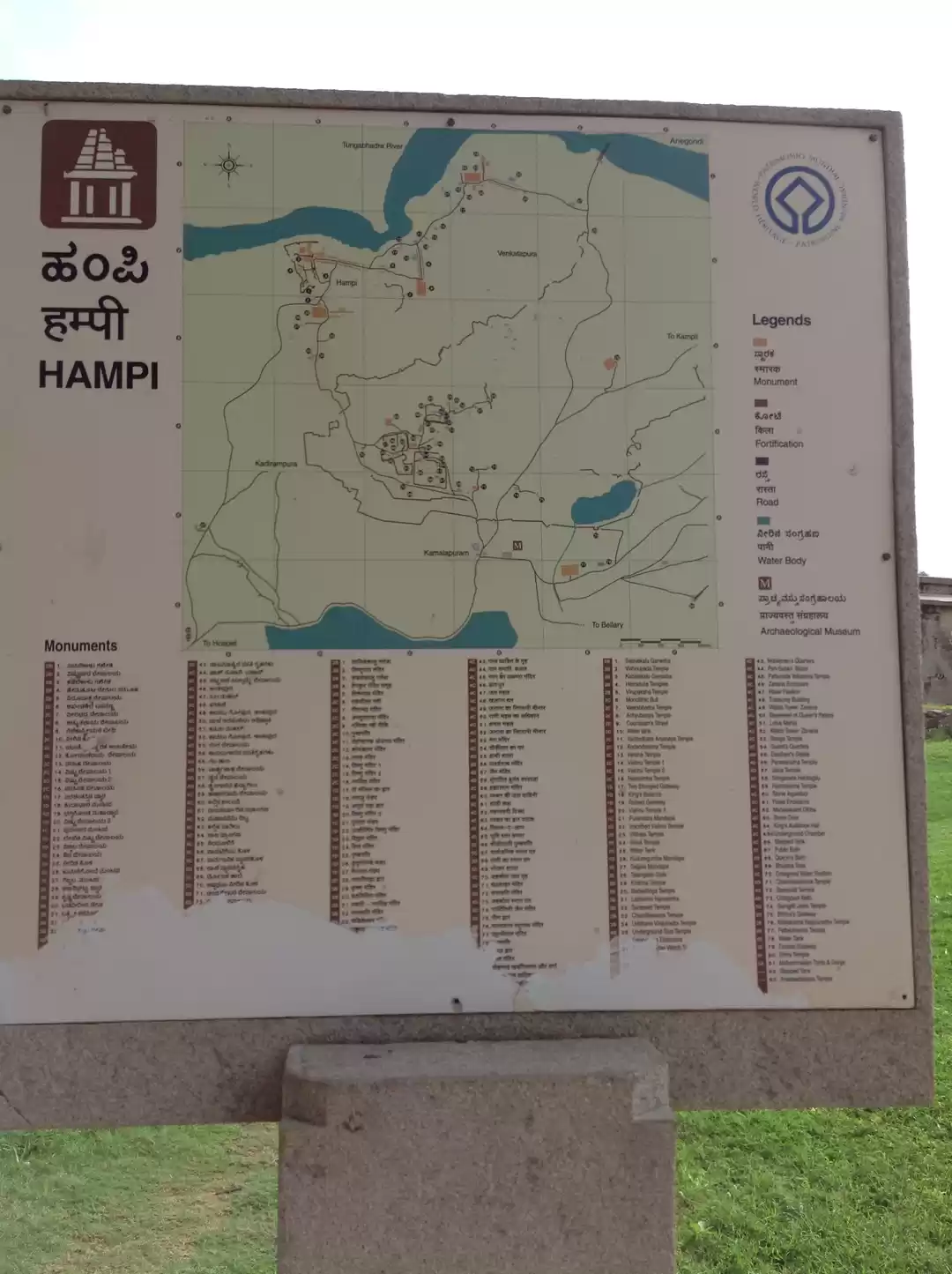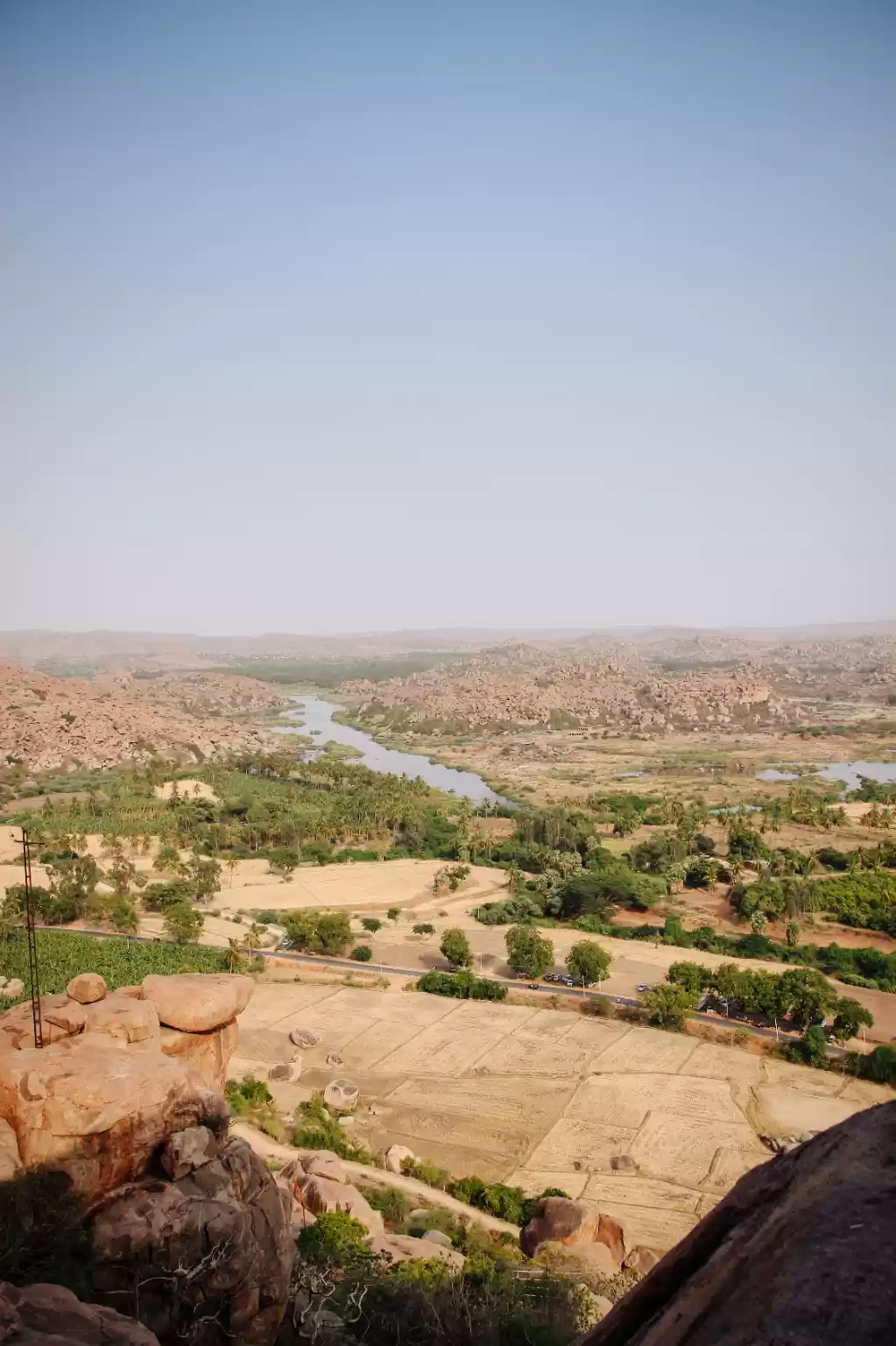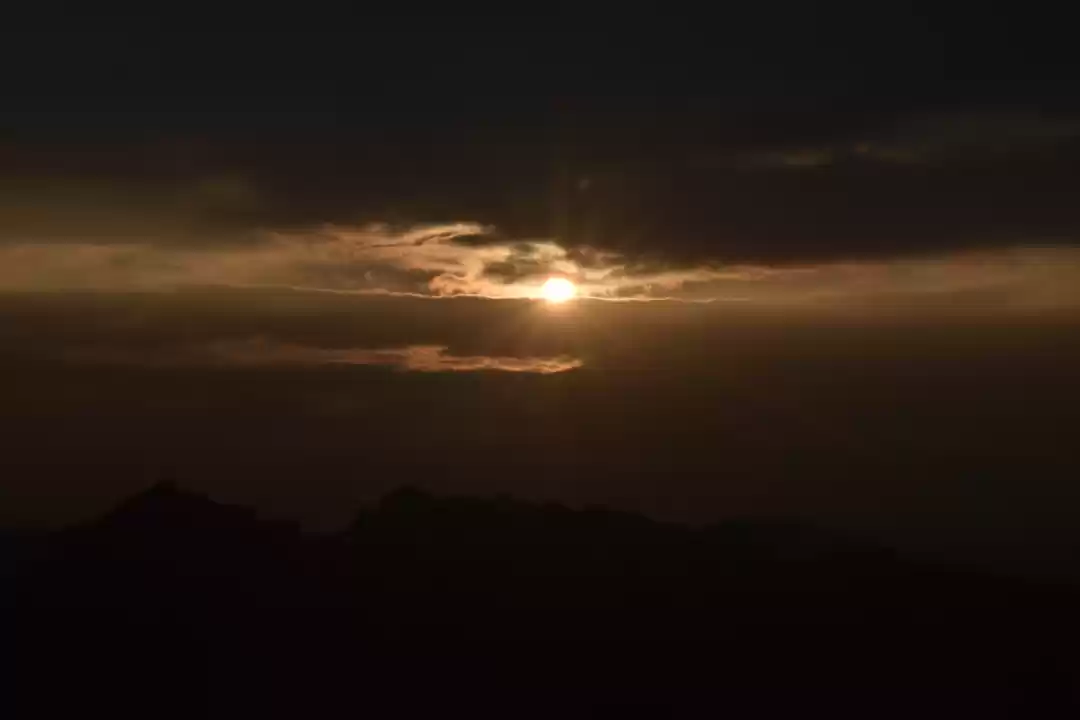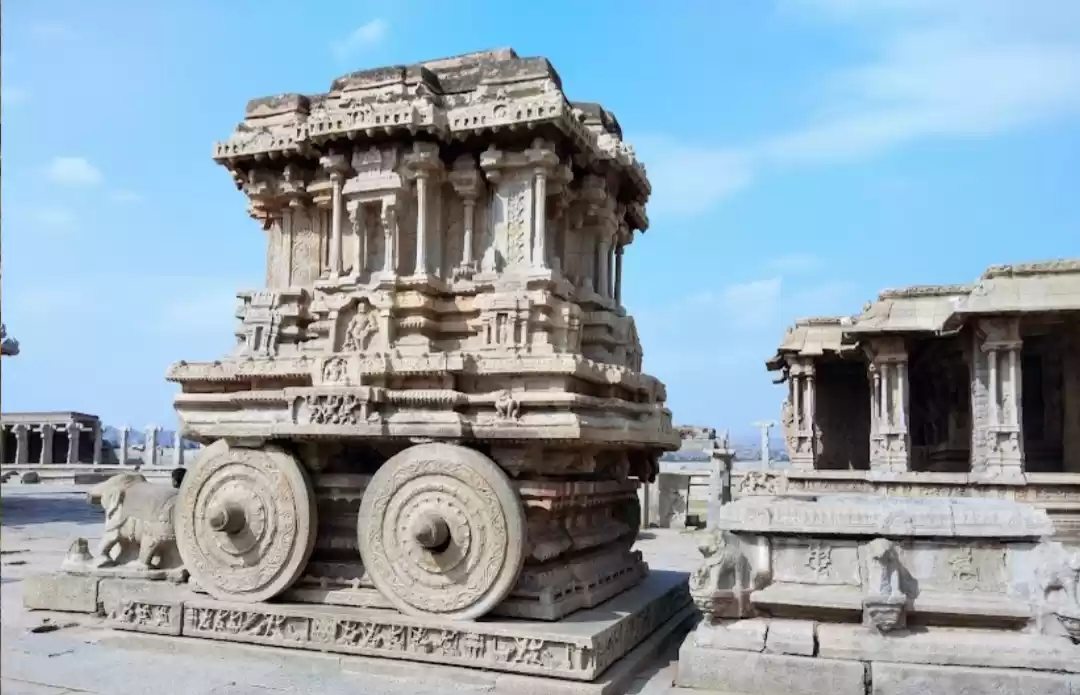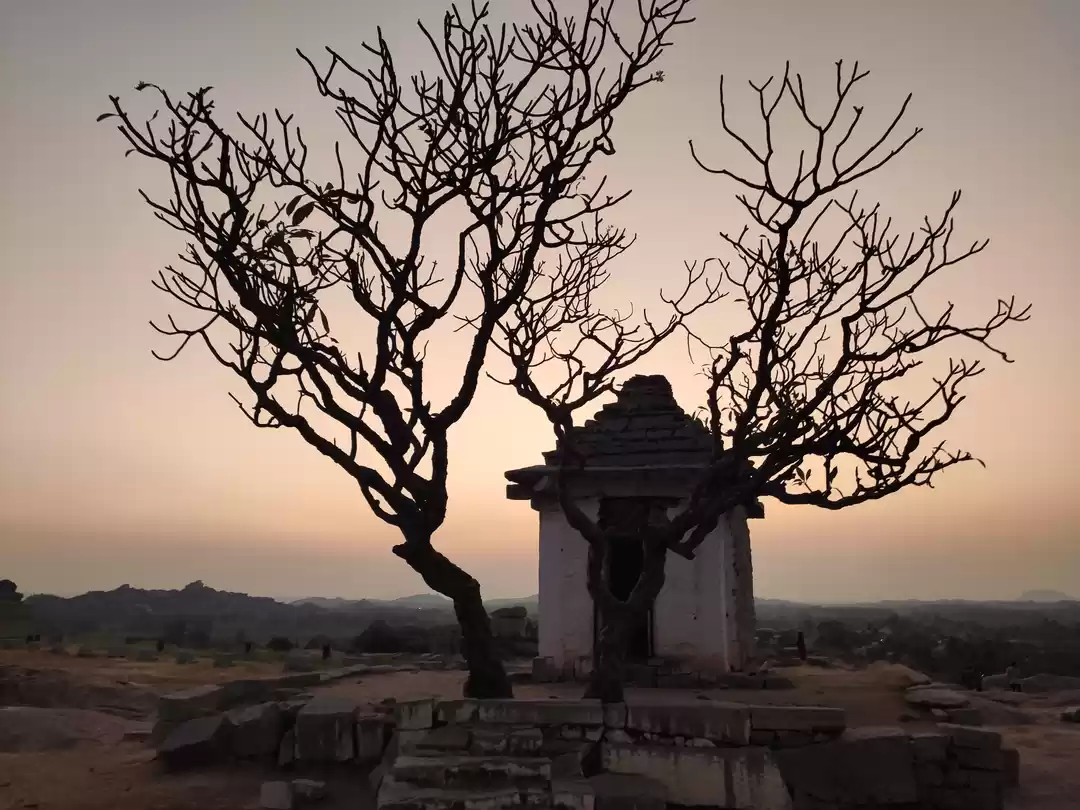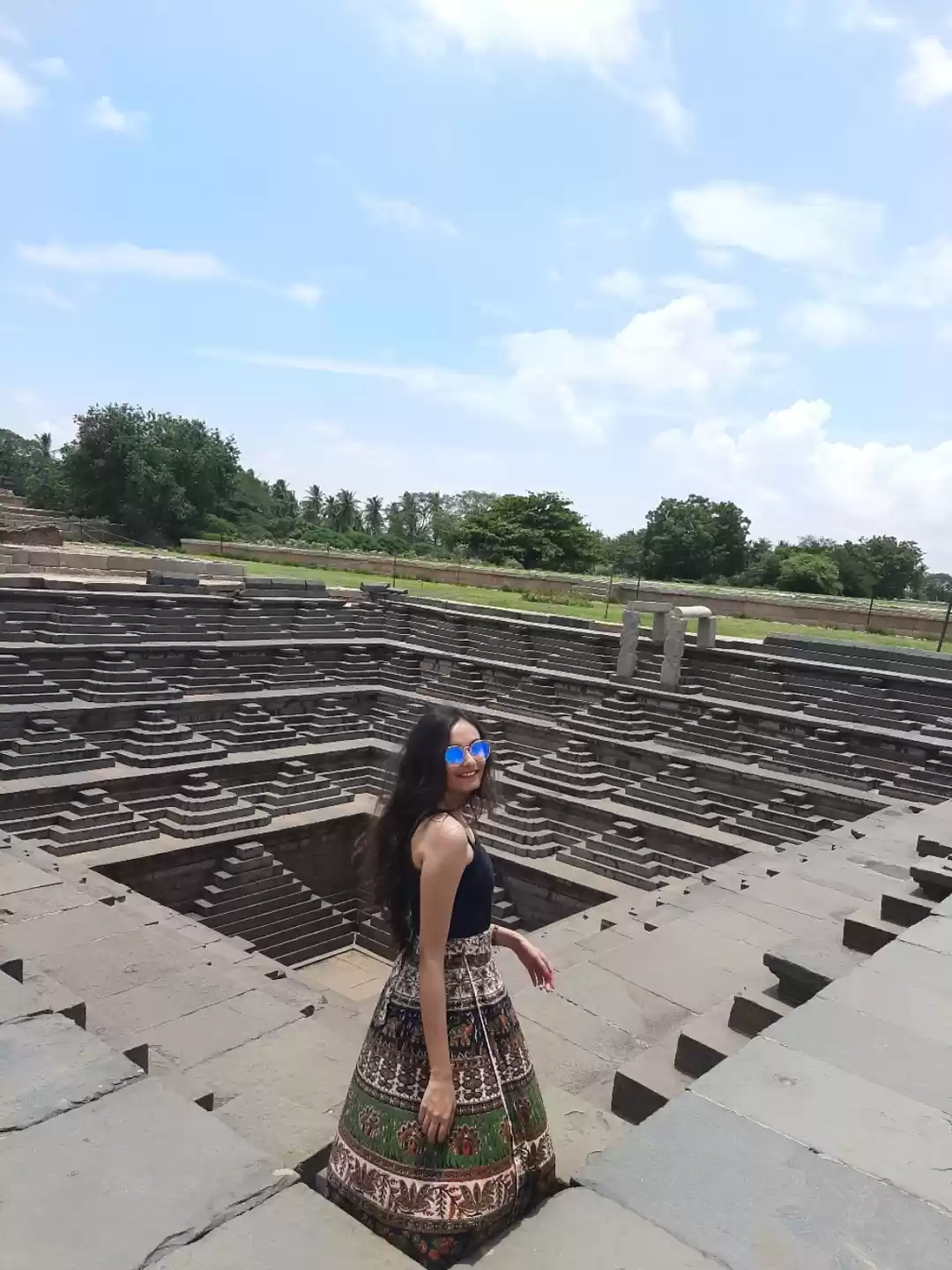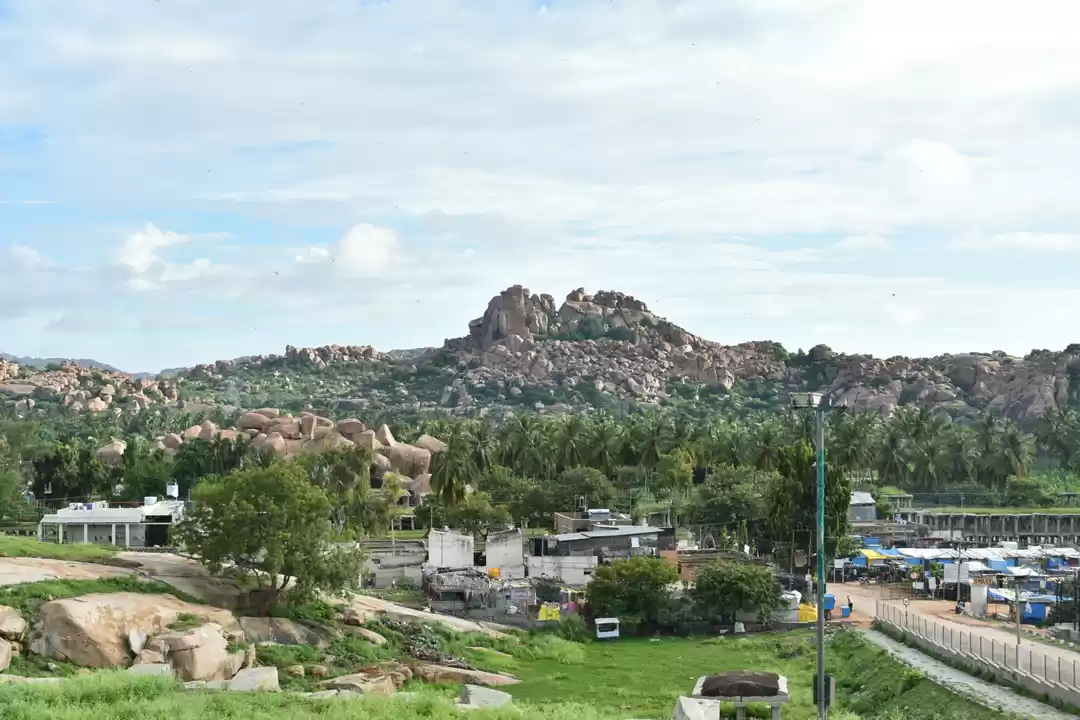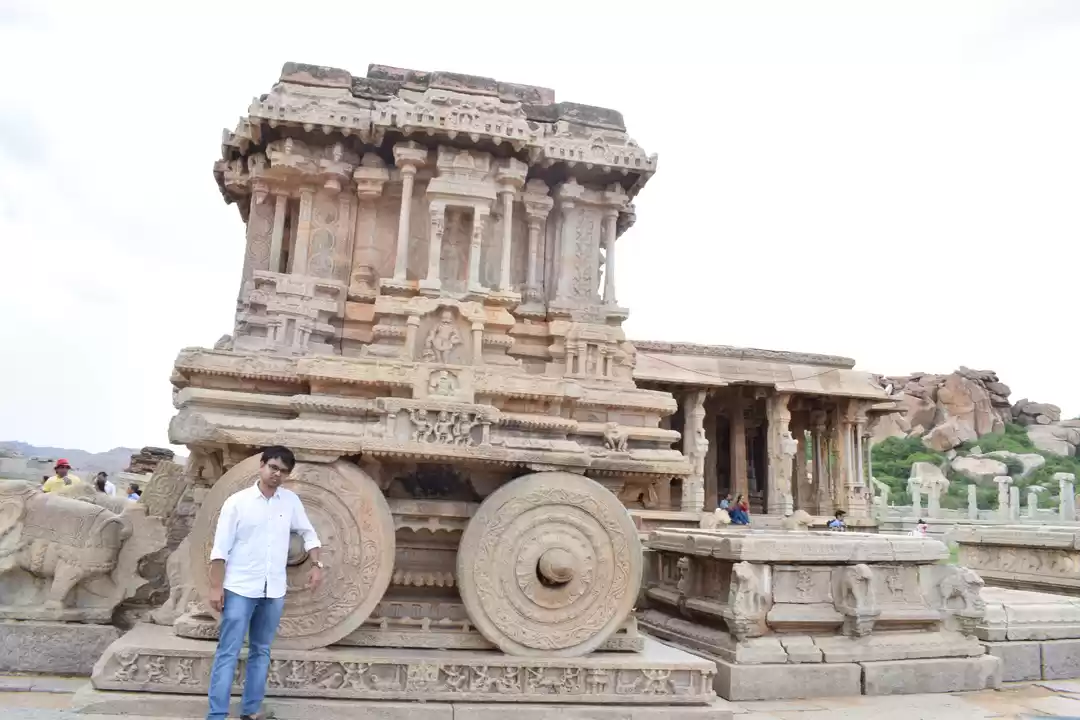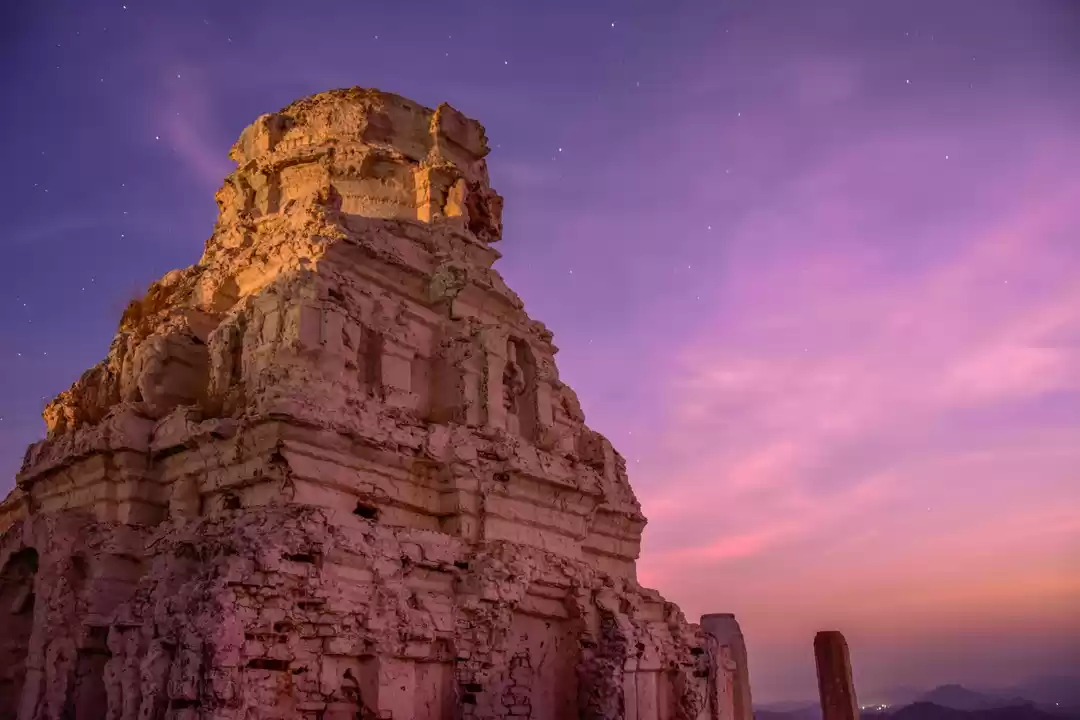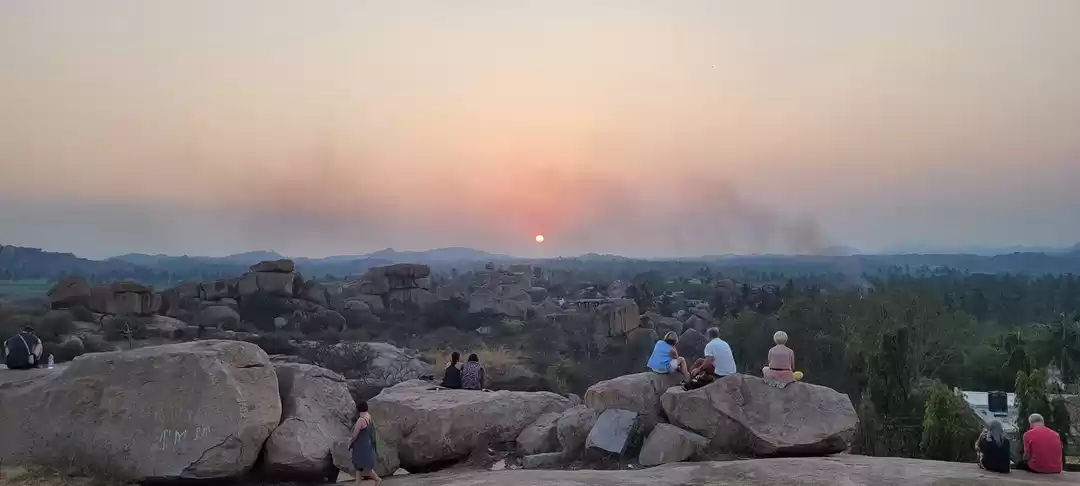
All I knew for several years about my country’s history was Mughals and British, as that is what our education system wanted to teach us.
But after I started reading about the true history of our country to explain to my kids, I started realizing that our country has SO much to be proud of! We have stories of 10,000+ years being said in our Puranas but – and these are not just mere stories, but actual events that happened in this very country!
I have been traveling the last 3 years to just heritage sites and can feel the aura of these places – one such gorgeous place is the pride of ancient India – Hampi – earlier Vijayanagar (the land of victory)!
Fact! New York times has rated Hampi second on the list of top 52 travel destinations across the world!
My husband and I took the super comfortable sleeper bus from Bangalore (6 hours night journey) and reached Hospet, Hampi at 4.45am.
Day1
We had booked a home stay just next to Hampi center near the Virupaksha temple (which was a 30 min auto ride from the bus stop). There were no free rooms at that time (5.30am) as the check-in time was 9.30am and hence our host (thankfully) asked us if we would like to climb Mathanga hill to see the sunrise. The hill was just 500m away and was a moderate 20-minute climb. Once you get your way through the rocks of Mathanga hill, you reach the top with a spectacular view of the entire Hampi city. Magnificent Boulders thrown all over the city with the Virupaksha temple at the center and the Tungabadra river flowing by its side on the West side of the hill and the Beautiful sunrise with the rays shining on all the rocks of Hampi on the East side. After a calm and quiet sunrise, we got down from another easier path with steps instead of rocks and head to our home-stay for some awesome breakfast.
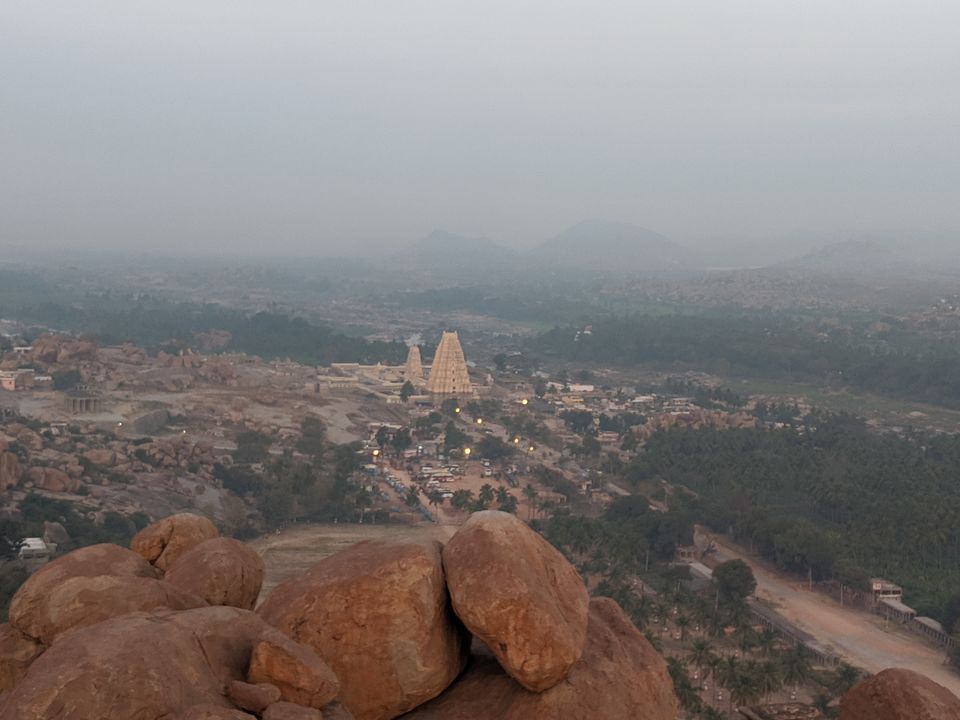
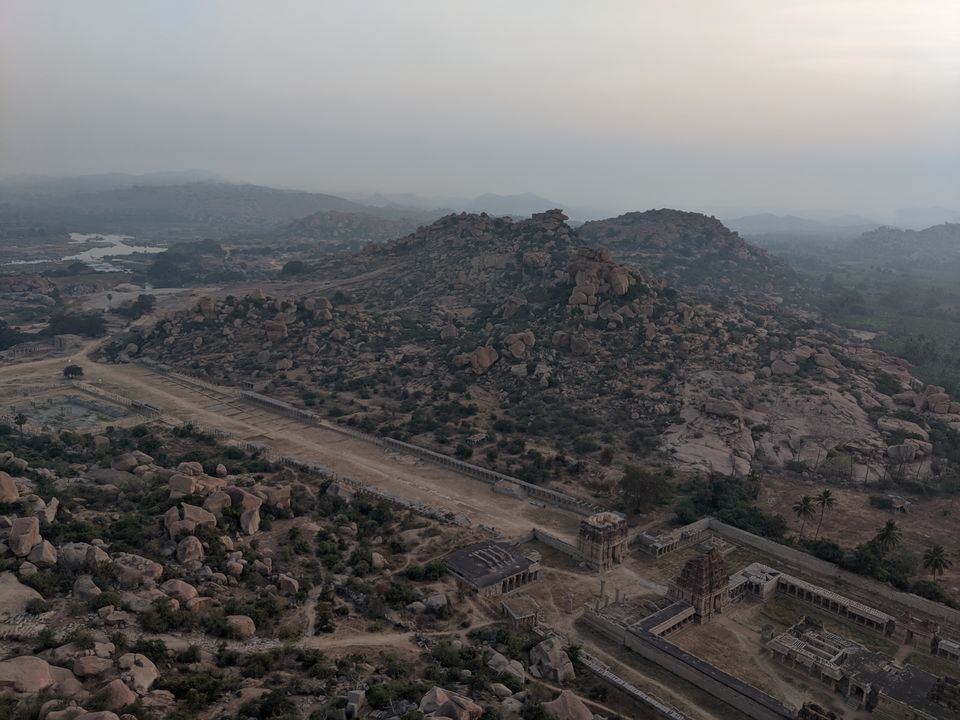
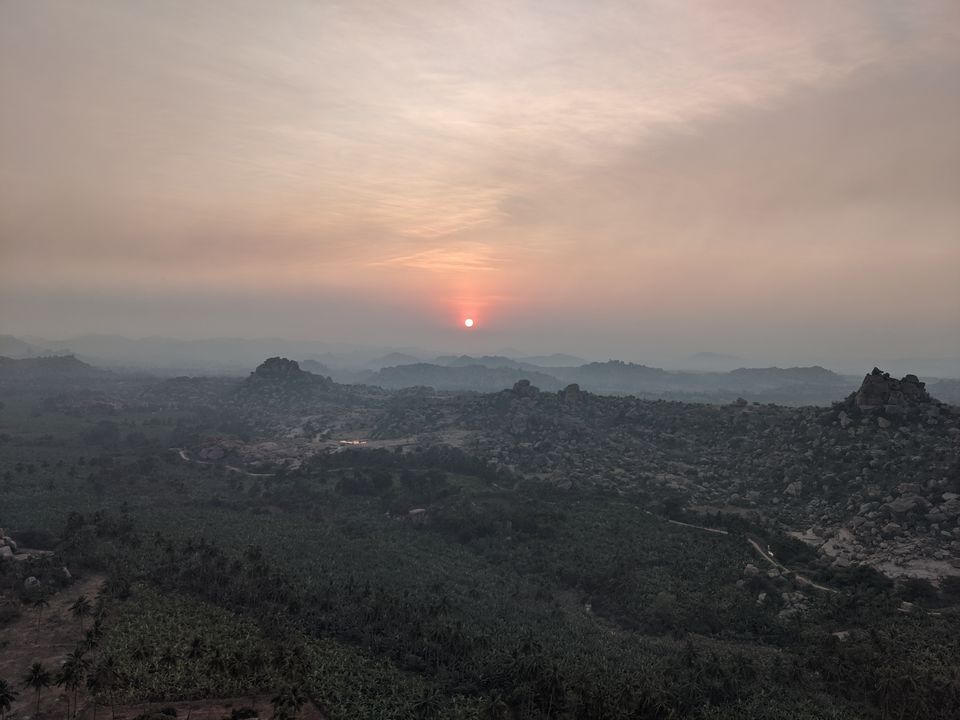
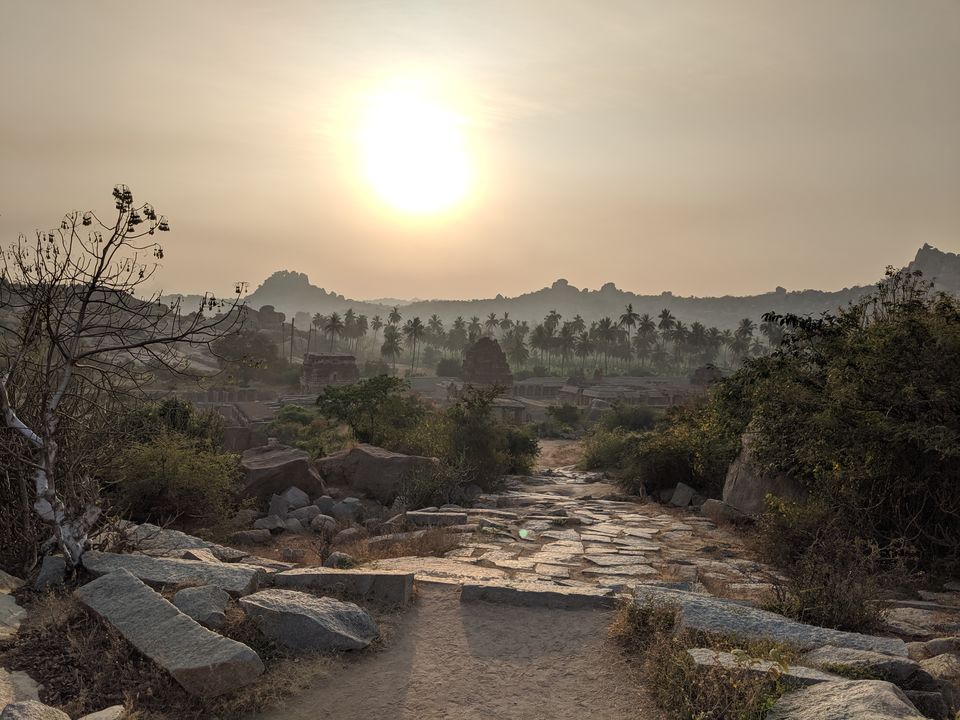
Some tips:
Where to stay:
If you are an easy go person, stay in homestays in Hampi as they are located in the center, with awesome food, surrounded by restaurants and shops, and you can even rent cycles for just Rs.100 here – and best of all- you get the real feel of the place! When you stay on the side where the Virupaksha temple is located, the home-stays are sober and quiet whereas the other side (just a 5-minute coracle/ferry ride to the other side) is the Hippie island – which have the fun, young and more happening home-stays.
After breakfast, we started walking towards the Virupaksha temple for the start of our Cycle tour. We had booked for a full day cycle tour (6 hours) to cover all the sites of interest.
Started at the Virupaksha temple.
History
Virupa – means formless and Aksha – means eyes.
Lord Shiva was meditating for around 3000 years at the Hemakunta hill just beside the Virupaksha temple. The demon Tarakasura was troubling the Devas and people for several years as he had a boon from Lord Shiva that only Lord Shiva’s son would be able to kill him. The Gods wanted to break his meditation as they wanted him to marry Parvathi and have a child who would kill Tarakasura. Parvathi devi was performing penance for several years at the river flowing close by – which was hence called Pampa (Parvathi’s other name) earlier – now Tungabhadra. Kama deva (the God of Love) was thus sent to break Shiva’s meditation and when he did so, Shiva in anger opened his third eye and burnt him to ashes. He however noticed Parvathi as well and agreed to marry her. On insistence of Kama’s wife and Parvathi, he did bring back Kama to life but without a body. Hence Kamadeva is also known as Ananga – without a body. The gods showered Gold from above during Shiva and Parvathi’s marriage and hence the hill where the marriage took place was called Hemakunta (Hema means Gold). Shiva and Parvathi then had a son Karthikeya who killed Tarakasura. The Virupaksha temple was built in between the Hemakunta hill and the Pampa river and the linga is a swayambu (not made but appeared on its own).

The Virupaksha-Pampa sanctuary existed for several thousands of years, but was the temple was built around it in the 7th century during the Chalukya and Hoyasala rule and completed during the Vijayanagara Empire rule. Apart from the Shiva linga, temple also a sanctum for Pampa Devi and other Gods and Goddesses.
Awe moment!
In the rear end of the temple, there is a small hole for light from the East Gopuram side to enter. This hole provides a pin-hole camera effect and on the wall opposite, where you can see an inverted reflection of the temple Gopuram! It is absolutely amazing to see this kind of effect being designed by our people centuries ago!


From here, we rode our cycles up the steep incline to the Kadalekalu Ganesha and Saasivekaalu Ganesha temple
Kadalekalu Ganesha
temple has a 15-feet monolithic (carved from a single rock) Ganesha idol. Situated on Hemakunta hill the temple got its name as the belly of Ganesha resembles the Bengal gram (Kadale in regional language). In ancient times, this temple was for the kings and royals and hence a smaller Ganesha temple was built for the masses which was the Saasivekaalu Ganesha temple.


Saasivekaalu Ganesha
is an 8-feet statue built in an open area, where Ganesha has a stomach in mustard (Saasive) shape. It is well known that Lord Ganesha loves his food. He once ate so much that his stomach was about to burst. He then tied a snake around his stomach to prevent it from bursting (and that’s the reason why you always see a snake around Ganesha’s belly). This statue has the snake around his belly, modak (his favorite food) on his top right hand and a noose on the left hand. The temple was built in the 15th century in memory of King Narasimha II of the Vijayanagara Empire.

Next halt- Krishna temple
The Krishna temple was built by the great king Sri Krishnadevaraya in 1513 AD after a conquest. The main idol was of Bala Krishna (infant Krishna) and this idol is now displayed in the State Museum at Chennai. The temple walls and pillars have beautiful carvings of our epics. It was destroyed during the Mughal invasion to quite an extent and the restoration work by the Government is currently ongoing.

The Hampi temples were not only built for spiritual upliftment and prayers but also as a place to stay for devotees traveling from far. The temples have art and culture halls, a visitor living area and even a cooking area which shows how people would travel from far and wide, live in these temples, and appreciate the dance, art and culture!
The area opposite the temple was the Krishna Bazaar which had rows of shops where trading used to happen. We can see the structure of rows of bazaar shops (7 such bazaars in total in Hampi) even now and the Krishna Bazaar leads to the Pushkarni (pond). You also get a magnificent view of the boulders of Matanga hill from here.



The city of Vijayanagara used to be one of the richest cities in the world and trading of spices, food items, oils and previous stones was thriving until the invasion.
We then got back on our cycles to the world-famous
Lakshmi Narasimha temple
This is the largest statue in Hampi - 22 feet in height. The statue is of the fourth incarnation of Lord Vishnu – Narasimha, and cut out of a single piece of stone. Here, Narasimha is seated in Yogic posture on the coil of the 7 headed snake Adishesha (King of all Naga’s) and AdiSesha’s head acts as a hood for Narasimha. Goddess Lakshmi was seated on his lap but during the invasion, the part where Lakshmi was seated was destroyed. During restoration, a belt is tied around the knees of the statue to hold it.
Next to the Narasimha statue is the gigantic
Shiva linga (Badavilinga)
in a small stone chamber filled with water. The linga is again a monolith 10 feet height. This Shiva linga was not destroyed during the invasion as it was miraculously hidden by itself!

Next stop – the underground Shiva temple. The
Prasanna Virupaksha temple
built in the 14th century is an underground Shiva temple built for the elite in the Vijayanagara kingdom. The temple has a stream of water from the Tungabhadra (Pampa devi) flowing through even now, thus keeping it cool always. The noblemen used to take rest here in the heat of the day and it was also used for royal private ceremonies.

This temple was buried underground for 400 years until it was discovered in the 1980’s decade. The temple is surrounded by a beautiful garden and is located just next to the Noblemen’s quarters.
Break for hydration!
The heat of Hampi at noon and cycling through the mild inclines did get us dehydrated and we stopped for the multiple reasonably priced options just on the streets – tender coconut water, goli soda, butter milk, sugar cane juice and fresh fruits!!
Next we enter the Royal Enclosure
HAZARA RAMA temple
After passing through the temples and bazaars and actually feeling the culture of the lost Vijayanagara empire, we now rode towards the Royal Enclosure – which is said to be spread over 59000 sq meters with palaces, temples, royal halls, ponds and other monuments included.
The first one on the route was the Hazara Rama temple. As the name indicates, the temple is dedicated to Lord Rama. The exterior walls of the temple have carvings of the scene when the warriors return from a successful war – thus showing the entire city welcoming the warriors with festivities and celebrations! The inside walls show the entire story of Ramayana! The temple was built in the early part of the 15th century.



Kings palace
The Hazara Rama temple leads to the King’s palaces. The palaces are now completely destroyed but from the archaeological studies (still ongoing), it is revealed that the palaces were spread over several thousand hectares consisting of underground meeting halls, palaces for the king, queens and other royals, durbars, celebration and culture halls, ponds, etc. The palace ceiling and several structures were carved on sandalwood which was later stolen during invasions and rest of the carvings burnt over 4-6 months – thus leaving just the remains and ruins of architecture marvels built over centuries! ☹
The king used to bathe in this pond before great ceremonies. The steps of the pond were built in pyramids symbolically indicating – 1 Universe, 3 Gods, Pacha (5) Bhutas, Saptha (7) Rishis and Nava (9) Grahas/planets. The water of the pond was said to be filled with the 7 holy rivers.

Lotus mahal and Elephant stable
Close to the palace is the Lotus Mahal. This remarkably designed mahal looks like an opened lotus bud. This is one of the few monuments not destroyed during the invasion probably due to its Islamic architecture. The royal ladies used to mingle around in the Lotus Mahal and enjoyed recreational activities here. Just a few yards from the Lotus mahal is the Elephant stable where the royal elephants were provided shelter.


Queen’s bath
Our last stop before lunch was the Queen’s bath. The queen used to have her massages and bath here while she could see her dancers on the sides of the beautifully carved and shaped building.

Our cycling tour thus came to an end and we stopped to have home made lunch (arranged by our cycling tour guide) under the trees. <3
Some of our fellow cyclists rode to the Vijaya Vittalla temple which has the famous Hampi Chariot – 6km away. This would complete the circle of the Royal Vijayanagara empire, but we chose to get back to our home-stay and head to the Virupaksha temple in the evening after a much needed afternoon nap! In the evening we sat for the Linga Abhishekam at the Virupaksha temple which was mesmerizing! For dinner, though you are spoilt with loads of options - several small hotels near Virupaksha temple, I strongly recommend the Mango tree restaurant – awesome food, low seating, lovely fusion music and the perfect ambiance!
I had planned the trip mainly to attend the Heritage Hampi Half marathon the next morning, and hence retired to sleep by 9pm though I would have loved to join my husband for his moonlight stroll.
DAY2
Heritage Hampi Half marathon
The next day started with an absolutely beautiful 21km run around the exact same route we had taken by cycle the previous day - from Virupaksha temple till Vittala temple and back.
After a beautiful run, yum breakfast and a fresh cold water bath to get some relief for my sore muscles, we were again ready – and this time to explore the other side of the island – Hippie Island, the Anjaneya hill (birth place of Lord Hanuman), Pampa Sarovar and conclude with the temple we missed the previous day – Vijaya Vittala temple!
We crossed over to the other side by taking the 5-minute ferry ride (Rs. 20 per passenger). As soon as landed on the other side, we found a bike rental place where we rented a 2-wheeler for the day! Filled just enough petrol to cover our spots of interest we rode through the shops of Hippie island and reached our first place for the day – Anjaneya hill – the birthplace of Lord Hanuman!
Anjaneya hill and trek to the temple
Back to some History
Several thousand years ago, Hampi was the land of the monkeys. Hanuman was the son of Anjana (hence his other name Anjaneya) and grew up here. When Rama, Sita and Lakshmana began their forest exile, they took the path (of today’s cities) -> Ayodhya - Prayagraj – Nashik (where Lakshmana cut Shurpanaka’s nose, hence the name Nashik) – Lepakshi (where Jatayu died after trying to save Sita from Ravana) – Hampi (where Rama met Hanuman) – Rameshwaram (the tip of India where they built the Ram Sethu bridge to cross over to SriLanka to get Sita back). Hence the Anjaneya hill is of great importance to Rama and Hanuman devotees.
The Anjaneya hill has 550 steps from base to top and then you reach the small temple. The view all through the climb is spectacular where you can see the whole of Hampi, its rocks and the whole of the Virupaksha temple area. Once you reach the top you can get a 360-degree view of Hampi.



The temple has a display of one of the rocks used to build the Ram Sethu bridge. Apparently, thousands of these heavy rocks when touched by Lord Rama began to float on water, and thus the bridge was built.

Since we were on a bike today and not cycles, distance was not a problem. When we were up the hill, we did notice the beautiful paddy fields amidst the huge boulders and hence took a ride on this beautiful path! It was scenic and totally movie like !

We didn’t want to exhaust all the petrol and hence decided to head to Pampa Sarovar which was just a few kms away.
Pampa Sarovar
Pampa Sarovar is one of the 5 sacred lakes in India, the others being – Mansarovar, Bindu Sarovar, Narayan Sarovar, Pushkar Sarovar. They are also mentioned in the Shrimad Bhagavata Purana. As per our Puranas, Pampa Sarovar is one of the places where Pampa Devi (Parvati) performed penance to show her devotion to Shiva. It is also the place where Shabari waited for several years for Lord Rama. Rama and Lakshmana did arrive at her ashram on their way to Lanka. It was Shabari who told Rama to take the help of Hanuman and Sugriva to get back Sita and showed him the way to Anjaneya hill.

After Pampa Sarovar, we rode around the streets of Anegudi and were then wondering what to do next. We then realized that if we waited to cross over by ferry after lunch at Hippie Island and then go to Vittala temple (by cycles or auto, as bikes are tough to get on that side of the island), it would be too late and hence filled the fuel tank and rode to Vijaya Vittala temple on the other side of Hampi (15km but a 30 min beautiful ride).
Vijaya Vittala temple
To reach the temple, one has to park 1km away and then take the government baggy’s (vehicles) or take a walk in hot sun. Looking at the long queue, we chose to walk. This 1km walk was in the Vijayanara time, the Vijaya Vittala market place and was famous for horse trading. The ruins of the market place can still be seen on either side. You get to see another Pushkarni (pond) just a few meters from the temple and then we enter the absolutely gorgeous temple.
The Stone chariot is the flagship tourist attraction of Hampi. Lord Vittala (Vishnu)’s vehicle is Garuda and this chariot earlier had a Garuda idol. The wheels of the chariot could be moved until some years ago, when the government cemented the wheels to avoid further damage to it.

Just in front of the chariot is the 15th century majestic main mantap and 3 smaller halls on the sides. The carvings on each of the pillars and walls of the temple and halls are stunning. The main mantap has 56 musical pillars which would create music on gently tapping them. The musical pillars were fascinating for one and all including the Britishers, who broke 2 of the pillars to understand if there was something inside – to find nothing practically. The broken pillars are still in the temple premises.




Our 1km walk back from the temple to the bike and our ride back to Hippie Island was in silence, remembering our royal kings, the Vijayanagara times, the great sculptors, our heritage and culture, Ramayana, Shiva, Pampa Devi and a whole world of thoughts! :)
Hippie Island
We then rode back to Hippie Island (the place is definitely a real contrast to the rest of Hampi and stands by its name). The restaurants were laid back, with great food and awesome music and total hippie style. After a great lunch, we returned the bike and got back on the ferry to the other side of the island.
I took a dip in the holy Pampa devi (Tungabhadra) and returned to our home-stay. We spent the rest of the evening in Hemakunta hill with a view of the awesome sunset and in meditation looking at Virupaksha temple, Anjaneya hill, Pampa Devi and thus looking inwards as well!
Some places not only teach you about your history and culture but also about who we are! Hampi is one such place – a Divine place for the spiritual and a Heritage site for the ones looking for beautiful ruins. Either way, it has something to offer for one and all!
As they say – Always Happy in Hampi! :)



